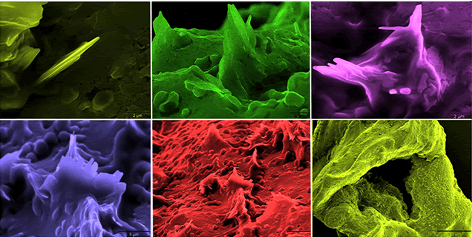Cholesterol
Crystals Trigger Inflammation Leading to Atherosclerosis
 |
 |
 |
 |
 |
 |
 |
| SUMMARY:
People with HIV have
a higher risk of cardiovascular disease compared with
the general population, which may be attributable in
part to elevated low-density lipoprotein (LDL) cholesterol
related to antiretroviral drugs and inflammation due
to ongoing low-level viral replication. Now, as reported
in the April
29, 2010 issue of Nature, researchers have
determined how cholesterol crystals contribute to atherosclerosis,
or "hardening of the arteries," a progressive
inflammatory condition that can lead to heart attacks
and strokes. |
|
 |
 |
 |
 |
 |
 |
 |
By
Liz Highleyman
Below
is an excerpt from a press
release issued by Michigan State University describing the
new study findings.
 |
| Caption:
The protruding elements seen in the different slides
are cholesterol crystals. Those elements are arising
from within the artery wall, causing tearing and damage
to the artery. The colors have been added for enhancement
and imagery (Source: Michigan State University). |
|
Cholesterol
Crystals Incite Inflammation in Coronary Arteries
East
Lansing, Mich. -- May 18, 2010 -- Cholesterol crystals, known
to be a catalyst for heart attacks and strokes, also cause cells
to send out danger signals that can lead to the inflammation and
hardening of arteries, according to a Michigan State University
cardiologist.
The discovery by George Abela, chief of the cardiology division
in MSU's College of Human Medicine, and a team of researchers
provides new insights into how arteries harden -- a process called
atherosclerosis -- and gives hope for new and early treatments
of cardiovascular disease.
The findings are published in the most recent edition of the journal
Nature.
Past research has shown that as cholesterol builds up along the
wall of an artery, it crystallizes from a liquid to a solid state
and expands, said Abela, who has been studying cholesterol crystals
for nearly a decade. As the crystals expand, they can disrupt
plaque and cause clotting, leading to cardiac attacks. That research
also was recently highlighted recently in the Journal of Clinical
Lipidology.
In a new discovery, Abela and the team -- while looking at causes
of inflammation during atherosclerosis in mice -- found that the
once cholesterol crystals form in the arterial wall, they activate
a biomarker called NLRP3 that induces inflammation.
"What we have found now, at the cellular level, is that the
crystals are an early cause rather than a late consequence of
inflammation," Abela said.
The discovery could lead to new treatments for heart disease.
"Since cholesterol crystals form very early in the process
of heart disease, with great potential to aggravate atherosclerosis,
we can target them early on," Abela said. "We can target
new therapies by reducing cholesterol crystal deposits early on
or use an inhibitor to block the inflammatory biomarker."
Abela added that the biomarker activated by the crystals could
be a better indicator of potential cardiovascular disease than
others, such as serum cholesterol, or the amount of cholesterol
found in the bloodstream.
"Now we treat atherosclerosis on the systematic level; with
this discovery we can also treat it the cellular level,"
he said.
Researchers
from several institutions across the globe took part in the project.
To review the article in Nature, go to www.nature.com.
To review the article in the Journal of Clinical Lipidology,
go to www.lipidjournal.com.
5/25/10
Source
Michigan
State University. Cholesterol Crystals Incite Inflammation in
Coronary Arteries. Press
release. May 18, 2010.
References
P
Duewell, H Kono, KJ Rayner, GS Abela, and others. NLRP3 inflammasomes
are required for atherogenesis and activated by cholesterol crystals.
Nature 464(7293): 1357-1361 (Abstract).
April 29, 2010.
GS
Abela. Cholesterol crystals piercing the arterial plaque and intima
trigger local and systemic inflammation. Journal of Clinical
Lipidology 4(3): 156-164(Abstract).
May 2010.
